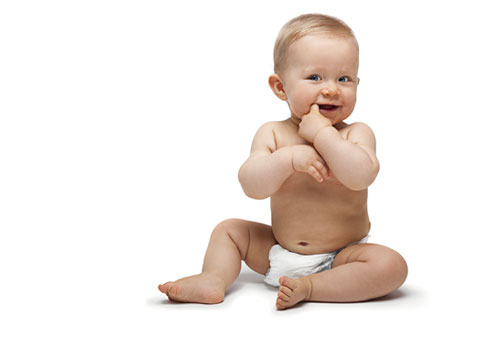




Physical development is divided into two, namely growth and development.
Growth represents the physical changes, the increase in size, height and weight.
Development involves the way in which children take control of their physical functions in order to undertake complex and difficult activities more easily and intricately.
Growth and development are connected as the development of physical skills relies on the child's size and muscular strength. Physical development will usually be in sequence although a child's age may vary. Several factors may affect the sequence, such as a disability.
A child’s head circumference is regularly checked and recorded on a percentile chart and compared to the norms for their age. The norms for boys and girls are slightly different. The head of a new-born baby is big compared to the rest of the body but as they develop it gets smaller in relation to the rest of their body. A child’s height and weight are recorded on percentile charts in their personal health record, or red book.
Boys and girls have different charts as boys tend to be a little heavier and taller, and their growth pattern is slightly different.
Signs of tooth breaking can start when a baby is 3 months old and the signs are painful red gums, red cheeks and dribbling. Primary teeth can appear when the baby is about 6 months old and the child usually has his or her full set of primary teeth when they reach the age of 3. Between the ages of about 6 and 7, children lose their primary teeth and permanent teeth begin to grow.
The development of the senses includes sight, hearing, touch, smell and taste. Babies discover the world through the senses. A child’s sensory skills will become more detailed as they get older. A baby’s sense of smell increases from birth to 8 years and by the time they are 1 week old they can recognise their mother’s breast milk. Babies aged 0-3 months enjoy doing a variety of movement and when they are about 7-9 months old, they begin to explore objects using hands and mouths.
Hearing operates fully after birth and by 3 months babies will respond to loud noises with a buzzing reflex and be awakened by loud voices and sounds. Babies respond to some voices with a smile and by 6 months they will not be afraid of everyday noises. By the age of 1, babies will respond to their name, the phone ringing, or someone’s voice, even when it is not loud. By the age of 2, they will begin enjoying listening to songs as well as use the words that they have learned.
Sight usually improves as a baby matures into childhood. After birth babies have poor eyesight but by the age of 1-month babies can look at faces and black and white pictures and watch their parent carefully. Between 5-7 months they will be able to see full colours and see further. By 2 years of age they will be able to focus on objects near and far and by 4 years of age their vision will almost be 20/20.
This involves the development and control of the entire body and larger muscles. Children need this control in order to balance, walk and climb. New-borns do not have much control over their bodies but, as they grow older their control grows. Children learn how to walk at a different rate to one another, with some learning to walk at 9 months old, whilst others are 12 months old and some are 18 months old.
Development moves from the head and down the body through the arms, hands, back, legs and feet. The downwards pattern is also relevant to ossification, namely the way in which children's bones harden. The bones of the hand harden before the bones of the feet. Ossification continues until the child reaches their teens.
Controlling the head
Rolling over
Sitting
Crawling
Standing
Walking
Running
Hopping
Climbing
This involves the development and control of the smallest muscles of the hands, fingers and feet so that the child can undertake finer tasks, e.g. drawing a picture, buttoning and threading beads. Development moves from the inside out, with functions close to the body developing into functions further away from the body, such as using the arm to reach out for an object before being able to use the fingers to pick the object up.
3 months - playing with the fingers
6 months - palmar grip (using the whole hand)
9 months - inferior pincer grip (using the index finger and thumb)
12 months - primitive tripod grip (thumb and two fingers)
15 months - palmar grip (to hold a crayon)
18 months - fine pincer grip and tripod grip
2 years old - one hand dominates
2 ½ years old - improved tripod grip
4 years old - mature pincer grip
Mae datblygiad corfforol wedi ei rannu'n ddau sef, twf a datblygiad.
Twf yw'r newidiadau ffisegol sef y cynnydd mewn maint, taldra a phwysau.
Datblygiad yw sut mae plant yn ennill rheolaeth dros eu gweithredoedd corfforol er mwyn cyflawni gweithgareddau cymhleth ac anodd yn haws ac yn fwy medrus.
Mae twf a datblygiad yn gysylltiedig oherwydd bod datblygiad sgiliau corfforol yn dibynnu ar faint y plentyn a'u cryfder cyhyrol. Fel arfer bydd datblygiad corfforol yn ddilyniant er y gall oedran plant amrywio ar y dilyniant hwnnw. Gall sawl ffactor megis anabledd effeithio ar y dilyniant.
Caiff cylchedd pen plentyn ei wirio yn rheolaidd a’u cofnodi ar siart canraddau a’u cymharu â’r normau ar gyfer eu hoedran. Mae’r normau i fechgyn a merched ychydig yn wahanol. Mae pen babi newydd-anedig yn fawr o gymharu â gweddill y corff ond wrth iddynt ddatblygu mae’n mynd yn llai mewn perthynas â gweddill eu corff.
Mae taldra a phwysau plant yn cael ei gofnodi ar siartiau canraddol yn eu cofnod iechyd personol, neu lyfr coch. Mae gan fechgyn a merched wahanol siartiau gan fod bechgyn yn tueddu i fod ychydig yn drymach ac yn dalach, ac mae eu patrwm twf ychydig yn wahanol.
Gall arwyddion torri dannedd ddechrau pan fydd babi’n 3 mis oed a’r arwyddion yw deintgig coch poenus, bochau coch a driblo. Gall dannedd cynradd ymddangos pan fydd y babi tua 6 mis oed, ac fel arfer, mae gan y plentyn ei set lawn yn cynnwys 20 o ddannedd cynradd erbyn iddynt gyrraedd 3 oed. Rhwng tua 6 a 7 oed, mae plant yn colli eu dannedd cynradd ac mae'r dannedd parhaol yn dechrau tyfu.
Mae datblygiad y synhwyrau'n cynnwys y golwg, y clyw, cyffwrdd, arogleuo a blasu. Mae babanod yn darganfod y byd trwy'r synhwyrau. Bydd sgiliau synhwyraidd plentyn yn mynd yn fwy manwl wrth fynd yn hŷn. Mae synnwyr arogli babanod yn cynyddu o enedigaeth hyd at 8 oed. Erbyn iddynt gyrraedd wythnos oed maent yn gallu adnabod llaeth y fron eu mam. Mae babanod 0-3 mis yn mwynhau gwneud amrywiaeth o symudiadau a phan fyddant rhwng tua 7-9 mis oed byddant yn dechrau archwilio gwrthrychau gan ddefnyddio eu dwylo a’u cegau.
Mae clyw yn gweithredu'n llawn ar ôl enedigaeth. Erbyn 3 mis bydd babanod yn ymateb i synau uchel gydag atgyrch dychryn ac yn cael eu deffro gan leisiau a synau uchel. Bydd babanod yn ymateb i rai lleisiau gyda gwên ac erbyn 6 mis ni fyddant ofn synau pob dydd. Erbyn 1 oed bydd babanod yn ymateb i'w henw, y ffôn yn canu, neu lais rhywun, hyd yn oed pan nad yw'n uchel. Byddant hefyd yn dechrau mwynhau gwrando ar ganeuon. Erbyn 2 oed bydd babanod yn defnyddio geiriau y maent wedi'u dysgu.
Mae golwg fel arfer yn gwella wrth i faban aeddfedu i blentyndod. Yn dilyn genedigaeth bydd gan fabanod olwg gwael ond erbyn mis oed gall babanod edrych ar wynebau a lluniau du a gwyn, a byddant yn gwylio’u rhiant yn ofalus. Rhwng 5-7 mis byddant yn gallu gweld lliwiau llawn, ac yn gallu gweld yn bellach. Erbyn 2 oedd bydd babanod yn gallu canolbwyntio ar wrthrychau yn agos ac yn bell, ac erbyn 4 mlwydd oedd bydd eu golwg bron yn 20/20.
Dyma ddatblygiad a rheolaeth y corff cyfan a'r cyhyrau mwy. Mae angen y rheolaeth yma ar blant er mwyn iddynt allu cydbwyso, cerdded a dringo. Nid oes gan fabanod newydd-anedig lawer o reolaeth dros eu cyrff ond wrth iddynt fynd yn hŷn, mae’r rheolaeth yn cynyddu. Mae plant yn dysgu'r rheolaeth i gerdded ar gyfradd wahanol i’w gilydd gyda rhai yn dysgu cerdded yn 9 mis oed, eraill yn 12 mis ac eraill yn 18 mis oed.
Mae datblygiad yn symud o'r pen ac i lawr y corff drwy'r breichiau, dwylo, cefn, coesau a thraed. Mae'r patrwm ar i lawr hefyd yn berthnasol i asgwrneiddiad sef y ffordd y mae esgyrn plant yn caledu. Mae esgyrn y dwylo'n caledu cyn esgyrn y traed. Nid yw asgwrneiddiad yn dod i ben nes bod y plentyn yn ei arddegau.
Rheoli’r pen
Rholio drosodd
Eistedd
Cropian
Sefyll
Cerdded
Rhedeg
Hercian
Dringo
Dyma ddatblygiad a rheolaeth cyhyrau lleiaf y dwylo, y bysedd a'r traed fel y gall plentyn wneud tasgau mwy manwl, e.e. tynnu lluniau, cau botymau ac edafu gleiniau. Mae datblygiad yn symud o'r tu mewn i'r tu allan gyda gweithrediadau sy’n agos at y corff yn datblygu i weithrediadau ymhellach oddi wrth y corff, megis defnyddio'r fraich i ymestyn am wrthrych cyn gallu defnyddio'r bysedd i godi'r gwrthrych.
3 mis - chwarae â’r bysedd
6 mis - gafael cledrol (defnyddio’r llaw gyfan)
9 mis - gafael pinsiwrn isradd (defnyddio’r mynegfys a’r bawd)
12 mis - gafael trybedd gysefin (bawd a dau fys)
15 mis - gafael cledrol (i ddal creon)
18 mis - gafael pinsiwrn manwl a gafael trybedd
2 oed - blaenoriaeth i un llaw
2 ½ oed - gafael trybedd wedi gwella
4 oed - gafael pinsiwrn aeddfed
Physical development norms
Click on a stages and select the appropriate statement from the list.
Cyfnodau o ddatblygiad plant
Cliciwch ar gamau a dewiswch y gosodiad priodol o’r rhestr.
Well done. You scored … out of ….
Da iawn. Mae gennych … allan o … yn gywir.
You scored … out of …. Some of the answers you gave are incorrect. Try again to improve your score.
Mae gennych … allan o … yn gywir. Mae rhai o'ch atebion yn anghywir. Ceisiwch eto i wella eich sgôr.